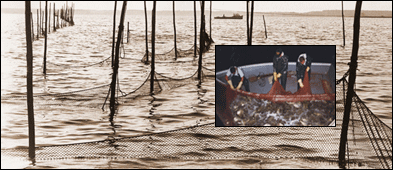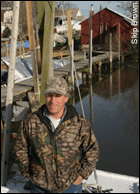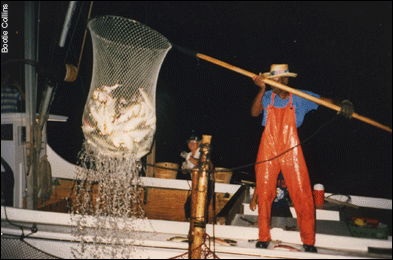Managing Fisheries for the Future
Photograph: A pound net on the Chesapeake; inset photo, waterman Bootie Collins' crew hauls in a pound net filled with stripers and other fish. By Skip Brown with inset photo by Bootie Collins.
Contents
|
|
|
|
|

Managing the Bay's Fisheries
The Search for New Approaches
By Merrill Leffler
How do our fishing practices affect the food web that supports all life in the Bay, from forage fish to top predators? Scientists are seeking to better understand these interrelationships and develop more holistic methods of managing sustainable fisheries in the Chesapeake.
Deale, Maryland, 4:30 a.m. It's days before Thanksgiving and Keith "Bootie" Collins is steering his workboat the Catherine C through the cold dark of Rockhold Creek on the Chesapeake's western shore. Huddled in the cabin for warmth, he and his three crew are headed for the Bay's open waters to harvest fish from several pound nets. The season for pound netters, open since April, will shut down on November 29th. For eight months Collins has been steering the same early morning route - while he will bring in white perch, croaker, menhaden, sea trout, eel and several other species, his money crop is striped bass.
What was hardly a faint glow ahead becomes more visible - the yellow light on Collins' first pound net, about two miles out from shore. As the Catherine C gets closer, the crew - Bryan Clark, Johnnie Smith and 76-year old Raymond "Tuck" Fountain - pull themselves into rubberized suits, effortlessly despite the cramped quarters. Collins maneuvers the workboat parallel to the leading edge of the pound net's crib - the cul de sac or "pocket" where fish are trapped - and secures it to the poles holding up the rest of the net. All four hustle into the skiff they've been trailing and paddle around the back edge of the crib. Once they position the skiff parallel to the workboat, they begin gathering the net inch by inch, securing it to hooks on the skiff, drawing both skiff and netted fish closer to the Catherine C.
The swirl of fins at the surface represents a waterborne livelihood to Collins and his crew, but what they find in their nets will also tell another story - about what kinds of fish now live in the Chesapeake Bay, and how those fish are tied to changes in the Bay's ecosystem as a whole. For now the crew of the Catherine C focuses on bringing in their catch.
Climbing back onto the larger workboat, Collins and Smith begin lowering a mechanized dip net that Clark and Fountain, both wielding shovels, rapidly fill with fish. Hoisted over the Catherine C's rail, the dip net suddenly releases a silver torrent of fish onto the culling board. To an angler, this is an immense haul, hundreds of fish hitting the culling board, nearly all of them striped bass, with a smattering of white perch, eels, brim shad, even crabs.
What happens next emblemizes current fisheries management in action. After quickly eyeballing the stripers, and rapidly measuring those too close to call, Collins and Smith shove most of them through the open end of the culling board, and right back into the Bay.
According to Maryland regulations, stripers must measure at least 18 inches and no longer than 36 inches - none of Collins' catch comes close to the latter and relatively few meet the minimum. Resource managers refer to these released stripers as "discards," in this case undersized fish that do not meet legal minimum lengths.
Collins and his crew hope that the ones they throw back will represent something of a silver lining, since they hold promise for a good season next year. But just how many of these discards will survive the physiological stress of being hauled up in the dip net, bounced on the culling board and shoved overboard remains uncertain.
For watermen like Collins, and for fisheries managers in the Chesapeake Bay, today's catch points to often frustrating realities and puzzling questions. For example, while some fish, like striped bass, may be plentiful, they may not meet size limits, and so don't meet the fisherman's needs. And while certain species, like striped bass, white perch, weakfish and croaker, have experienced population growth in recent years, other species, most notably menhaden and the valuable Bay blue crab, have declined. Meanwhile, oyster populations are at all-time lows and sturgeon and shad are off-limits to all fishermen.
What are the relationships between one species and another? How do current fisheries practices, such as throwing back undersized or illegal fish, actually preserve stocks? In what ways does the restoration of one species like striped bass potentially impact prey species like blue crab and menhaden or competitor species such as bluefish and weakfish? How do our fishing practices affect the food web that supports all life in the Bay, from forage fish to top predators?

Hoisting a heavy dip net,
a crewman on Bootie Collins' boat (right) hauls fish from the pound net's "pocket." The season over for 2003, Collins (above) prepares to ready his boat for the next season.

![[Maryland Sea Grant]](/GIFs/h_footer_mdsg.gif)